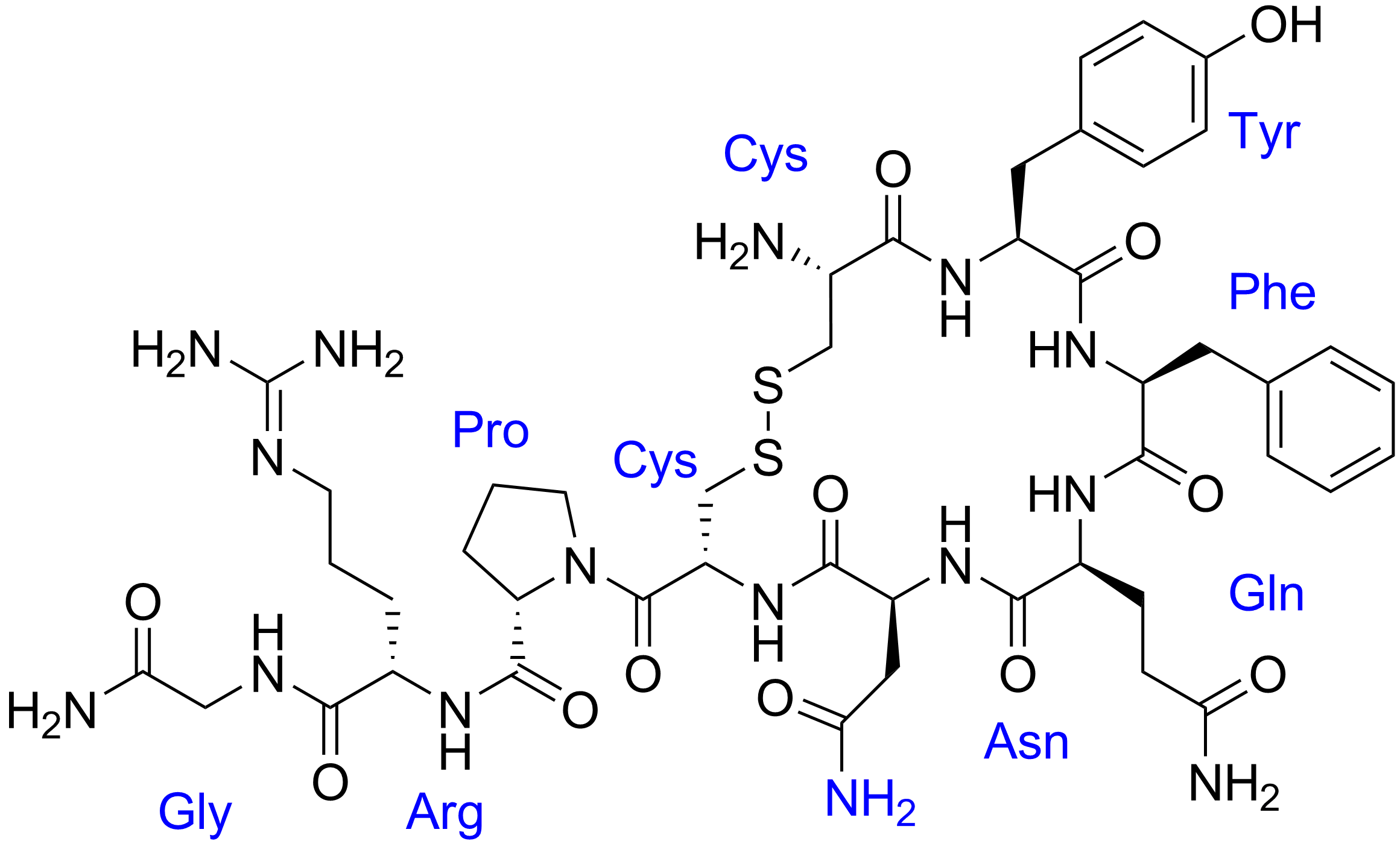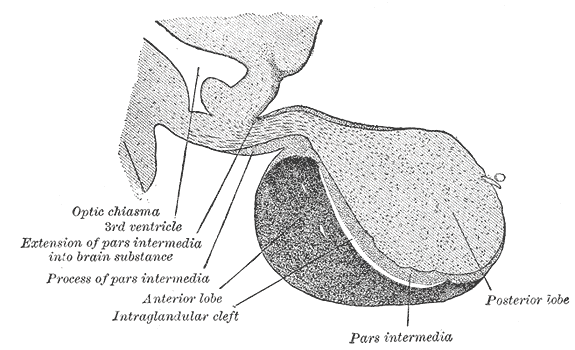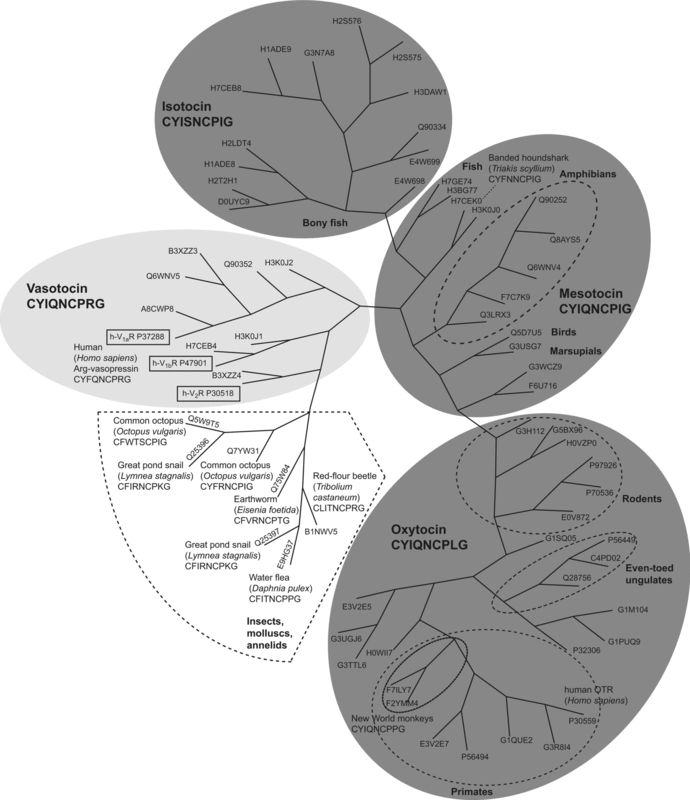|
Vasopressin
Human vasopressin, also called antidiuretic hormone (ADH), arginine vasopressin (AVP) or argipressin, is a hormone synthesized from the AVP gene as a peptide prohormone in neurons in the hypothalamus, and is converted to AVP. It then travels down the axon terminating in the posterior pituitary, and is released from vesicles into the circulation in response to extracellular fluid hypertonicity (hyperosmolality). AVP has two primary functions. First, it increases the amount of solute-free water reabsorbed back into the circulation from the filtrate in the kidney tubules of the nephrons. Second, AVP constricts arterioles, which increases peripheral vascular resistance and raises arterial blood pressure. A third function is possible. Some AVP may be released directly into the brain from the hypothalamus, and may play an important role in social behavior, sexual motivation and pair bonding, and maternal responses to stress. Vasopressin induces differentiation of stem cells in ... [...More Info...] [...Related Items...] OR: [Wikipedia] [Google] [Baidu] |
Vasopressin Receptor 1A
Vasopressin receptor 1A (V1AR), or arginine vasopressin receptor 1A (officially called AVPR1A) is one of the three major receptor types for vasopressin (Arginine vasopressin receptor 1B, AVPR1B and Arginine vasopressin receptor 2, AVPR2 being the others), and is present throughout the brain, as well as in the periphery in the liver, kidney, and vasculature. V1AR is also known as: * V1a vasopressin receptor * antidiuretic hormone receptor 1A * SCCL vasopressin subtype 1a receptor * V1-vascular vasopressin receptor AVPR1A * vascular/hepatic-type arginine vasopressin receptor Structure and function Human AVPR1A cDNA is 1472 bp long and encodes a 418 amino-acid long polypeptide which shares 72%, 36%, 37%, and 45% sequence identity with rat Avpr1a, human AVPR2, rat Avpr2, and human Oxytocin receptor, oxytocin receptor (OXTR), respectively. AVPR1A is a G protein-coupled receptor, G-protein coupled receptor (GPCR) with 7 transmembrane domains that couples to Gq alpha subunit, Gaq/11 ... [...More Info...] [...Related Items...] OR: [Wikipedia] [Google] [Baidu] |
AVP Gene
Arginine Vasopressin (AVP) Gene is a gene whose product is proteolytically cleaved to produce vasopressin (also known as antidiuretic hormone (ADH)), neurophysin II, and a glycoprotein called copeptin. AVP and other AVP-like peptides are found in mammals, as well as mollusks, arthropods, nematodes, and other invertebrate species. In humans, AVP is present on chromosome 20 and plays a role in homeostatic regulation. The products of AVP have many functions that include vasoconstriction, regulating the balance of water in the body, and regulating responses to stress. Expression of AVP is regulated by the Transcription Translation Feedback Loop (TTFL), which is an important part of the circadian system that controls the expression of clock genes. AVP has important implications in the medical field as its products have significant roles throughout body. Discovery Vasopressin The discovery of the AVP gene first required the discovery of one of its key products: vasopressin. In 1 ... [...More Info...] [...Related Items...] OR: [Wikipedia] [Google] [Baidu] |
Vasopressin Receptor 1B
Vasopressin V1b receptor (V1BR) also known as vasopressin 3 receptor (VPR3) or antidiuretic hormone receptor 1B is a protein that in humans is encoded by the ''AVPR1B'' (arginine vasopressin receptor 1B) gene. V1BR acts as a receptor for vasopressin. AVPR1B belongs to the subfamily of G-protein coupled receptors. Its activity is mediated by G proteins which stimulate a phosphatidylinositol-calcium second messenger system. It is a major contributor to homeostasis and the control of water, glucose, and salts in the blood. Arginine vasopressin has four receptors, each of which are located in different tissues and have specific functions. AVPR1b is a g-protein coupled pituitary receptor that has only recently been characterized because of its rarity. It has been found that the 420-amino-acid sequence of the AVPR1B receptor shared the most overall similarities with the AVP1A, AVP2 and oxytocin receptors. AVPR1B maps to chromosome region 1q32 and is a member of the vasopressin/oxytocin ... [...More Info...] [...Related Items...] OR: [Wikipedia] [Google] [Baidu] |
Vasopressin Receptor 2
Vasopressin receptor 2 (V2R), or arginine vasopressin receptor 2 (officially called AVPR2), is a protein that acts as receptor for vasopressin. AVPR2 belongs to the subfamily of G-protein-coupled receptors. Its activity is mediated by the Gs type of G proteins, which stimulate adenylate cyclase. AVPR2 is expressed in the kidney tubule, predominantly in the membrane of cells of the distal convoluted tubule and collecting ducts, in fetal lung tissue and lung cancer, the last two being associated with alternative splicing. AVPR2 is also expressed outside the kidney in vascular endothelium.Jackson EK (2018). "Drugs Affecting Renal Excretory Function". In: Brunton LL, Hilal-Dandan R, Knollmann BC. eds. ''Goodman & Gilman's: The Pharmacological Basis of Therapeutics'', 13e New York, NY: McGraw-Hill. Stimulation causes the release of von Willebrand factor and factor VIII from the endothelial cells. Because von Willebrand factor helps stabilize circulating levels of factor VIII, the va ... [...More Info...] [...Related Items...] OR: [Wikipedia] [Google] [Baidu] |
Supraoptic Nucleus
The supraoptic nucleus (SON) is a nucleus of magnocellular neurosecretory cells in the hypothalamus of the mammalian brain. The nucleus is situated at the base of the brain, adjacent to the optic chiasm. In humans, the SON contains about 3,000 neurons. Function The cell bodies produce the peptide hormone vasopressin, which is also known as anti-diuretic hormone (ADH), and the peptide hormone oxytocin. Both of these peptides are released from the posterior pituitary. ADH travels via the bloodstream to its target cells in the papillary ducts in the kidneys, enhancing water reabsorption. OT travels via the bloodstream to act at the mammary glands and the uterus. In the cell bodies, the hormones are packaged in large, membrane-bound vesicles that are transported down the axons to the nerve endings. The secretory granules are also stored in packets along the axon called Herring bodies. Similar magnocellular neurons are also found in the paraventricular nucleus. Signaling Each neuro ... [...More Info...] [...Related Items...] OR: [Wikipedia] [Google] [Baidu] |
Desmopressin
Desmopressin, sold under the trade name DDAVP among others, is a medication used to treat diabetes insipidus, bedwetting, hemophilia A, von Willebrand disease, and high blood urea levels. In hemophilia A and von Willebrand disease, it should only be used for mild to moderate cases. It may be given in the nose, by injection into a vein, by mouth, or under the tongue. Common side effects include headaches, diarrhea, and low blood sodium. The low blood sodium that results may cause seizures. It should not be used in people with significant kidney problems or low blood sodium. It appears to be safe to use during pregnancy. It is a synthetic analogue of vasopressin, the hormone that plays roles in the control of the body’s osmotic balance, blood pressure regulation, kidney function, and reduction of urine production. Desmopressin was approved for medical use in the United States in 1978. It is on the World Health Organization's List of Essential Medicines. It is available as ... [...More Info...] [...Related Items...] OR: [Wikipedia] [Google] [Baidu] |
Diuretic
A diuretic () is any substance that promotes diuresis, the increased production of urine. This includes forced diuresis. A diuretic tablet is sometimes colloquially called a water tablet. There are several categories of diuretics. All diuretics increase the excretion of water from the body, through the kidneys. There exist several classes of diuretic, and each works in a distinct way. Alternatively, an antidiuretic, such as vasopressin ( antidiuretic hormone), is an agent or drug which reduces the excretion of water in urine. Medical uses In medicine, diuretics are used to treat heart failure, liver cirrhosis, hypertension, influenza, water poisoning, and certain kidney diseases. Some diuretics, such as acetazolamide, help to make the urine more alkaline, and are helpful in increasing excretion of substances such as aspirin in cases of overdose or poisoning. Diuretics are sometimes abused by people with an eating disorder, especially people with bulimia nervosa, with the goa ... [...More Info...] [...Related Items...] OR: [Wikipedia] [Google] [Baidu] |
Paraventricular Nucleus Of Hypothalamus
The paraventricular nucleus (PVN, PVA, or PVH) is a nucleus in the hypothalamus. Anatomically, it is adjacent to the third ventricle and many of its neurons project to the posterior pituitary. These projecting neurons secrete oxytocin and a smaller amount of vasopressin, otherwise the nucleus also secretes corticotropin-releasing hormone (CRH) and thyrotropin-releasing hormone (TRH). CRH and TRH are secreted into the hypophyseal portal system and act on different targets neurons in the anterior pituitary. PVN is thought to mediate many diverse functions through these different hormones, including osmoregulation, appetite, and the response of the body to stress. Location The paraventricular nucleus lies adjacent to the third ventricle. It lies within the periventricular zone and is not to be confused with the periventricular nucleus, which occupies a more medial position, beneath the third ventricle. The PVN is highly vascularised and is protected by the blood–brain barrier, althou ... [...More Info...] [...Related Items...] OR: [Wikipedia] [Google] [Baidu] |
Posterior Pituitary
The posterior pituitary (or neurohypophysis) is the posterior lobe of the pituitary gland which is part of the endocrine system. The posterior pituitary is not glandular as is the anterior pituitary. Instead, it is largely a collection of axonal projections from the hypothalamus that terminate behind the anterior pituitary, and serve as a site for the secretion of neurohypophysial hormones (oxytocin and vasopressin) directly into the blood. The hypothalamic–neurohypophyseal system is composed of the hypothalamus (the paraventricular nucleus and supraoptic nucleus), posterior pituitary, and these axonal projections. Structure The posterior pituitary consists mainly of neuronal projections (axons) of magnocellular neurosecretory cells extending from the supraoptic and paraventricular nuclei of the hypothalamus. These axons store and release neurohypophysial hormones oxytocin and vasopressin into the neurohypophyseal capillaries, from there they get into the systemic circulation ... [...More Info...] [...Related Items...] OR: [Wikipedia] [Google] [Baidu] |
Sexual Motivation And Hormones
Sexual motivation is influenced by hormones such as testosterone, estrogen, progesterone, oxytocin, and vasopressin. In most mammalian species, sex hormones control the ability and motivation to engage in sexual behaviours. Measuring sexual motivation Sexual motivation can be measured using a variety of different techniques. Self-report measures, such as the Sexual Desire Inventory, are commonly used to detect levels of sexual motivation in humans. Self-report techniques such as the bogus pipeline can be used to ensure individuals do not falsify their answers to represent socially desirable results. Sexual motivation can also be implicitly examined through frequency of sexual behaviour, including masturbation. Hormones Testosterone Testosterone appears to be a major contributing factor to sexual motivation in male primates, including humans. The elimination of testosterone in adulthood has been shown to reduce sexual motivation in both male humans and male primates. Male humans ... [...More Info...] [...Related Items...] OR: [Wikipedia] [Google] [Baidu] |
Oxytocin Receptor
The oxytocin receptor, also known as OXTR, is a protein which functions as receptor for the hormone and neurotransmitter oxytocin. In humans, the oxytocin receptor is encoded by the ''OXTR'' gene which has been localized to human chromosome 3p25. Function and location The OXTR protein belongs to the G-protein coupled receptor family, specifically Gq, and acts as a receptor for oxytocin. Its activity is mediated by G proteins that activate several different second messenger systems. Oxytocin receptors are expressed by the myoepithelial cells of the mammary gland, and in both the myometrium and endometrium of the uterus at the end of pregnancy. The oxytocin-oxytocin receptor system plays an important role as an inducer of uterine contractions during parturition and of milk ejection. OXTR is also associated with the central nervous system. The gene is believed to play a major role in social, cognitive, and emotional behavior. A decrease in OXTR expression by methylation of th ... [...More Info...] [...Related Items...] OR: [Wikipedia] [Google] [Baidu] |
Hypothalamus
The hypothalamus () is a part of the brain that contains a number of small nuclei with a variety of functions. One of the most important functions is to link the nervous system to the endocrine system via the pituitary gland. The hypothalamus is located below the thalamus and is part of the limbic system. In the terminology of neuroanatomy, it forms the ventral part of the diencephalon. All vertebrate brains contain a hypothalamus. In humans, it is the size of an almond. The hypothalamus is responsible for regulating certain metabolic processes and other activities of the autonomic nervous system. It synthesizes and secretes certain neurohormones, called releasing hormones or hypothalamic hormones, and these in turn stimulate or inhibit the secretion of hormones from the pituitary gland. The hypothalamus controls body temperature, hunger, important aspects of parenting and maternal attachment behaviours, thirst, fatigue, sleep, and circadian rhythms. Structure T ... [...More Info...] [...Related Items...] OR: [Wikipedia] [Google] [Baidu] |





